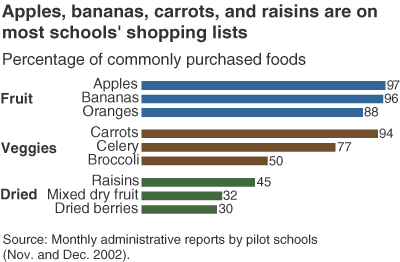Free Fruit and Vegetable Snacks a Big Hit in Schools
- by Jean C. Buzby and Joanne Guthrie
- 11/1/2003
Free fruit and vegetable snacks were provided to over 64,000 children in elementary and secondary schools as part of USDA’s Fruit and Vegetable Pilot Program (FVPP). In an effort to promote fresh fruit and vegetable consumption among school children and encourage healthy dietary choices, 107 elementary and secondary schools in 5 States (Indiana, Iowa, Michigan, New Mexico, and Ohio) participated in the FVPP for the 2002-03 school year. Students in participating schools were from diverse ethnic backgrounds and family income levels. The program was popular among most students, parents, school teachers, principals, pilot managers, foodservice staff, and representatives of State child nutrition programs. School staff and students recognized health benefits from the pilot program such as increased consumption of fruits and vegetables, reduced consumption of less healthy food, fewer unhealthy snacks brought from home, and lessened risk of obesity.
An evaluation of the pilot program by ERS found that the program’s flexibility was key to its success. Schools were allowed to choose when, where, and how to implement the program as well as the mix and quantities of foods offered. Initial concerns, such as difficulties with implementation, disruptions of classes, and possible messiness of the foods, were largely addressed. For example, teachers coordinated classroom activities with snack times. Some elementary schools changed food delivery from hallways to the classroom to better monitor behavior. The offerings were also modified to suit student tastes, to conform to different delivery methods (for example, whole fruits in free vending machines), and to accommodate daily preparation time. To address time and labor concerns, some schools offered more prepackaged items, such as bagged baby carrots.
Although the pilot program had ample funding, many schools cited the requirement to use no more than 10 percent of their grant money for nonfood costs (for example, administrative costs, such as extra labor) as too restrictive. This cost ceiling was implemented to ensure that the bulk of the money would be spent on fruits and vegetables and could be adjusted if the program were to continue. Nationwide expansion of the pilot program would cost an estimated $4.5 billion, based on an average annual cost of $94 per student and a count of 48.2 million children in public schools in 2001. Costs would be higher if private schools also participated. Based on the popularity of the pilot program, it may be expanded to other States.
This article is drawn from:
- Buzby, J.C., Guthrie, J. & Kantor, L. (2003). Evaluation of the USDA Fruit and Vegetable Pilot Program: Report to Congress. U.S. Department of Agriculture, Economic Research Service. EFAN-03-006.


